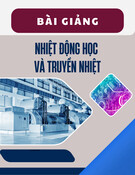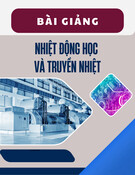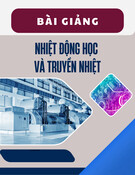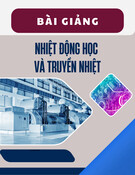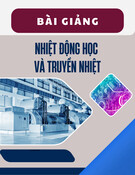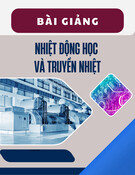
REVIEW ARTICLE
Safety assessments and severe accidents, impact of external
events on nuclear power plants and on mitigation strategies
Jean-Pierre Van Dorsselaere
1
, Ahmed Bentaib
1,*
, Thierry Albiol
1
, Florian Fichot
1
, Alexei Miassoedov
2
,
Joerg Starflinger
3
, Holger Nowack
4
, and Gisela Niedermayer
4
1
IRSN, BP17, Fontenay-aux-Roses 92262, France
2
International Atomic Energy Agency, Vienna International Centre, P.O. Box 100, 1400 Vienna, Austria
3
University of Stuttgart, Institute of Nuclear Technology and Energy Systems (IKE), Pfaffenwaldring 31, 70569 Stuttgart,
Germany
4
Gesellschaft für Anlagen- und Reaktorsicherheit (GRS) mbH, Schwertnergasse 1, 50677 Köln, Germany
Received: 12 March 2019 / Accepted: 4 June 2019
Abstract. The Fukushima-Daiichi accidents in 2011 underlined the importance of severe accident management
(SAM), including external events, in nuclear power plants (NPP) and the need of implementing efficient
mitigation strategies. To this end, the Euratom work programmes for 2012 and 2013 was focused on nuclear
safety, in particular on the management of a possible severe accident at the European level. Relying upon the
outcomes of the successful Euratom SARNET and SARNET2 projects, new projects were launched addressing
the highest priority issues, aimed at reducing the uncertainties still affecting the main phenomena. Among them,
PASSAM and IVMR project led by IRSN, ALISA and SAFEST projects led by KIT, CESAM led by GRS and
sCO
2
-HeRO lead by the University of Duisburg-Essen. The aim of the present paper is to give an overview on the
main outcomes of these projects.
1 Introduction
Despite accident prevention measures, including design
modification and operating procedures, used in the nuclear
power plants (NPP), under operation, some accidents,
within very low probability, may evolve into severe
accidents with core melting and plant damage and lead
to release and dispersion of radioactive materials into the
environment, thus constituting a danger for the public
health and for the environment. This risk was unfortu-
nately evidenced by the Fukushima Daiichi accidents in
Japan in March 2011, which underlined the importance of
severe accident management and the need to implement
and to improve the corresponding mitigation strategies
and systems.
The severe accident phenomena are complex and
cannot be addressed completely within the framework of
a national research program, therefore the collaboration at
European and international level is needed. The integra-
tion of the European severe accident research facilities into
a pan- European laboratory for severe accident helps
understanding the possible accident scenarios and related
phenomena and contributes to improve safety of existing
and, future reactors.
To achieve these ambitious objectives, several projects
were launched under the auspices of EURATOM with the
aim at:
–filling the gap of knowledge and reducing the uncertain-
ties on phenomena participating in severe accidents such
as the core degradation, the core melt and the hydrogen
deflagration as addressed in the framework of ALISA and
SAFEST projects,
–developing new mitigation systems and strategies to
reduce the source term release in the framework of
PASSAM project and a system for heat removal in the
framework of the sCO
2
-HeRo project,
–improving the mitigation strategies in support to the in-
vessel retention as done in the framework of the IVMR
project,
–improving the ASTEC code suitability to address severe
accident phenomena and severe accident management
for a large number of reactor design including PWR,
BWR, VVER and CANDU.
The aim of the present paper is to give an overview of
the main outcomes of the PASSAM, CESAM, SAFEST,
*e-mail: ahmed.bentaib@irsn.fr
EPJ Nuclear Sci. Technol. 6, 39 (2020)
©J.P. Van Dorsselaere et al., published by EDP Sciences, 2020
https://doi.org/10.1051/epjn/2019010
Nuclear
Sciences
& Technologies
Available online at:
https://www.epj-n.org
This is an Open Access article distributed under the terms of the Creative Commons Attribution License (http://creativecommons.org/licenses/by/4.0),
which permits unrestricted use, distribution, and reproduction in any medium, provided the original work is properly cited.

ALISA, IVMR and sCO
2
-HeRo projects. Their main
achievements regarding the safety improvement and their
complementarity will be highlighted.
2 PASSAM project
The PASSAM [1–3] (Passive and Active Systems on Severe
Accident source term Mitigation) project was launched
within the 7th framework programme of the European
Commission and coordinated by IRSN. During this four
year project (2013–2016) nine partners from six countries:
IRSN, EDF and University of Lorraine (France); CIEMAT
and CSIC (Spain); PSI (Switzerland); RSE (Italy); VTT
(Finland) and AREVA GmbH (Germany) were involved.
The PASSAM project aimed at exploring potential
enhancements of existing source term mitigation devices
and checking the capacity of innovative systems to achieve
even larger source term attenuation (acoustic agglomera-
tion systems; high pressure spray agglomeration systems;
electric filtration systems; improved zeolite filtration
systems; combined filtration systems). Thus, the per-
formed R&D program was mainly of experimental nature,
and addressed phenomena able to reduce the radioactive
releases to the environment in case of a severe accident.
Consequently the project major outcome was an
extensive and sound database that could help the utilities
and regulators to assess the performance of the existing
source term mitigation systems, to evaluate potential
improvements of these systems and to develop severe
accident management (SAM) measures. In addition,
simple models and/or correlations have been proposed
for these systems. Within the objective that their
implementation in severe accident analysis codes would
help the enhancement of their capability to model SAM
measures and to improve the existing guidelines.
Pool scrubbing has been addressed as a first priority
topic. It has been demonstrated that the in-pool gas
hydrodynamics under anticipated conditions is quite
different from the model currently implemented in severe
accident analysis codes, particularly at high velocities (i.e.,
jet injection regime and churn-turbulent flow). Addition-
ally, it has been proved that maintaining a high pH in the
scrubber solution in the long run is absolutely necessary for
preventing a late iodine release. Sand bed filters (plus
metallic pre-filters) showed-out inefficient for gaseous
molecular and/or organic iodides; moreover, it was
demonstrated that cesium iodide aerosols trapped in the
sand filter during a severe accident are unstable allowing
a potential delayed source term. On the contrary, CsI
particles trapped in the metallic pre-filter do not lead to
any significant delayed release. Innovative processes, as
acoustic agglomeration and high pressure spray systems
were studied with the aim of producing bigger particles
upstream of filtered containment venting systems (FCVS),
which enhance the filtration efficiency. Actually an
increase of the particle size by ultrasonic fields was
experimentally observed. Moreover, the hard-to-filter
particles (i.e., 0.1–0.3 mm) were drastically reduced in
the particle size distribution. The increase in particle size
by high pressure sprays could not be measured. However,
the system showed a better efficiency regarding the
airborne particle concentration which was lower than for
low pressure sprays. The performed studies for trapping
gaseous molecular and organic iodine using wet electro-
static precipitators (WESP) confirmed the importance of
optimizing the WESP design and the need of some pre-
WESP steps (e.g. oxidation of I
2
or CH
3
I into iodine oxide
particles) to improve the trapping efficiency. Extensive
testing of zeolites as gaseous iodine trapper was performed.
The results showed very good trapping efficiencies,
particularly the so-called silver Faujasite-Y zeolite. Final-
ly, the combination of a wet scrubber followed by a zeolite
filtration stage was extensively studied in representative
severe accident conditions and showed the ability of this
configuration to reach a significant retention for gaseous
organic iodides. Small and mid-size facilities have been
used for these experimental campaigns: Figure 1 shows a
few of them (mostly addressing pool scrubbing research).
Heavily relying on experiments, the PASSAM project
provided new data on the ability and reliability of a number
of systems related to FCVS: pool scrubbing systems, sand
bed filters plus metallic prefilters, acoustic agglomerators
[2], high pressure sprays, electrostatic precipitators,
improved zeolites and combination of wet and dry systems.
Nonetheless, the scope of some of the PASSAM research
topics as fission products and aerosol retention in water
ponds goes beyond FCVS and might be applied for
accident situation other than containment venting, e.g. for
fission product scrubbing in the wet well of a BWR or for
Steam Generator Tube Rupture (SGTR) accident with
submerged secondary side.
Complementary to the experimental investigations, the
focus was put on trying to get a deeper understanding of the
phenomena underlying their performance and to develop
models/correlations that allow modelling of the systems in
accident analysis codes, like ASTEC.
3 ALISA project
The ALISA project [4] (Access to Large Infrastructure
for Severe Accidents) is a European FP7 Project (Grant
Agreement No: 295421). It is a unique project between
European and Chinese research institutions in the area
of severe accident research providing a shared access to
large research infrastructures to study severe accident
phenomena.
Such an access to large research infrastructure through
ALISA allows optimal use of the R&D human and financial
resources in Europe and in China in the complex field of
severe accident analysis for existing and future power
plants and promotes the collaboration among nuclear
utilities, industry groups, research centres, TSOs and
safety authorities, in Europe and China. This is precisely
the main objective of the ALISA project. Large-scale
facilities of the ALISA project are designed to resolve the
most important still pending severe accident safety
issues, ranked with high or medium priority by the SARP
group for SARNET NoE. These issues are the coolability of
a degraded core, the corium coolability in the RPV, the
possible melt dispersion to the reactor cavity, the molten
2 J.P. Van Dorsselaere et al.: EPJ Nuclear Sci. Technol. 6, 39 (2020)

corium concrete interaction and the hydrogen mixing and
combustion in the containment. The ALISA program
objective is to understand the effect that these events may
have on the safety of existing reactors and to define suitable
soundly based accident management procedures. The main
aim is not only understanding the physical background of
severe accidents but also providing with the underpinning
knowledge that can help to reduce the severity of the
consequences.
In the framework of the project, access to six Chinese
facilities belonging to four Chinese research organizations
was allowed to European users and six facilities from KIT
and CEA were opened to the Chinese partners. The project
started on July 1, 2014 and lasted for four years. Two calls
for proposals have been undertaken during the project
followed by the evaluation and selection of proposals by the
User Selection Panel. All the facilities offered for access in
Europe and in China have received proposals. The
European facilities are QUENCH, LIVE, DISCO, HYKA
at KIT, and KROTOS, VITI at CEA, and the Chinese
facilities are COPRA from Xían Jiaotong University
(XJTU), HYMIT and WAFT from Shanghai Jiaotong
University (SJTU), and IVR2D, IVE3D from CNPRI and
MCTHBF from Nuclear Power Institute of China (NPIC).
The nature of the majority of the Chinese proposals reveals
the high demand to evaluate the safety design of their own
reactor types. Since some EU and Chinese proposals
investigate similar phenomena but in different scale and
geometry, such as LIVE and COPRA, HYKA, HYMIT and
MCTHBF, the comparison of the test results provide a
broader range of applicability. Other proposals investigate
different aspects of a same severe accident strategy, such as
LIVE and IVR2D/IVR3D. The gained knowledge can
provide comprehensive understanding of the phenomena of
in-vessel melt retention with external cooling.
A wide range of European and Chinese organizations
have participated in the elaboration of the experimental
proposals as well as the preparation and analysis of the
experiments. Due to strong links to other European
projects, ALISA offers a unique opportunity for all partners
to get involved in the networks and activities supporting
safety of existing and advanced reactors and to get access to
large-scale experimental facilities in Europe and in China
to enhance understanding reactor core behaviour under
severe accident conditions (Fig. 2).
4 SAFEST project
SAFEST [5] (Severe Accident Facilities for European
Safety Targets) is a European project networking the
European corium experimental laboratories and CLADS/
JAEA, Japan. The duration of the project is 4.5 years and it
was scheduled to end in December 2018. The safest
objective is to address the still pending severe accident
issues related to accident analysis and corium behaviour in
Light Water Reactors.
Moreover, and due to the links to other European
projects or platforms (e.g. CESAM, IVMR, NUGENIA/
SARNET, etc.), the SAFEST project offers a unique
opportunity for all parties to get involved in the networks
and activities supporting safety of existing and advanced
Fig. 1. Some selected PASSAM experimental facilities.
J.P. Van Dorsselaere et al.: EPJ Nuclear Sci. Technol. 6, 39 (2020) 3

reactors and to get access to large-scale experimental
facilities in Europe dealing with core behaviour under
severe accident conditions.
The project is a valuable asset for the fulfilment of the
severe accident R&D programs that are being set up after
Fukushima and the subsequent European stress tests,
addressing both national and European objectives. It has
the aim of establishing coordination activities, enabling the
development of a common vision and research roadmaps
for the next years, and of the management structure to
achieve these goals.
Roadmaps on European severe accident experimental
research for light water reactors and for GenIV technolo-
gies have been developed. Joint R&D has been conducted
to improve the excellence of the SAFEST facilities: that
includes the corium physical properties measurements, the
improvement of these instrumentation, the consensus on
scaling law rationales and cross comparison of material
analyses.
Joint experimental research was a clear objective in the
SAFEST project to provide solutions for the mitigation of
severe accident and the limitation of consequences for the
current GEN II and III plants. Consequently, the
knowledge obtained in SAFEST shall improve severe
accident management measures. In addition, it offered
competitive advantages for the nuclear industry and
contributed to the long-term sustainability of nuclear
energy.
A direct outcome from the SAFEST project was the
progress towards the creation of an integrated pan-
European laboratory for study of corium behaviour in
severe accident conditions. Indeed, it covers a very large
spectrum of nuclear reactors severe accident phenomenol-
ogy dealing with corium (mainly oriented at LWRs, even
though several aspects of Gen IV severe accidents can be
studied in some of the SAFEST facilities). By strengthen-
ing the links between European corium facility operators,
preparing a common roadmap for future EU research and
improving the capabilities and performance of experimen-
tal facilities, this laboratory shows-up a valuable asset for
the fulfilment of severe accident R&D programs which are
being set up after Fukushima-Daiichi and the subsequent
stress tests both at the national level and at the European
level.
The main results of SAFEST activities include a better
understanding of the physical background of severe
accidents and a prototypic corium behaviour. It profits
to the EU utilities and safety organizations, which will be
able to validate (either directly through the access to the
SAFEST distributed infrastructure or indirectly through
R&D) the hypotheses and assumptions adopted for severe
accident scenarios and propose pertinent procedures for
accident mitigation taking into account experimental
results. The experimental results will be used for the
development and validation of models and their imple-
mentation in the severe accident codes such as ASTEC,
MELCOR, and ATHLET-CD. This enables capitalizing in
the codes and in the scientific databases the outcomes of
severe accident research, thus allowing preserving and
divulgating the knowledge to a large number of current and
future end users in Europe.
5 CESAM project
The CESAM (Code for European Severe Accident
Management) project goal was to enhance the ASTEC
software system, which is the European reference for the
study and the management of core melt accidents for all
types of second- and third-generation nuclear power plants
(Gen.II and Gen.III NPPs). CESAM [6–8] was launched in
April 2013 under the European Commission’s Seventh
Framework Program for Research and Development (FP7)
and concluded in March 2017. Coordinated by GRS
(Germany) with a major contribution from IRSN,
the project brought together 18 European and 1 Indian
partner.
The CESAM project aimed at achieving a better
understanding of all relevant phenomena of the Fukushima
Daiichi accidents and of their importance for SAM (Severe
Accident Management) measures, as well as improving the
ASTEC computer code (see Fig. 3) to simulate plant
behaviour throughout the accidental sequences including
the SAM measures. The analysis of current SAM measures
implemented in European plants was the project starting
point.
Fig. 2. COPRA test facility in Xi’an Jiatong University to study
melt behaviour in the RPV lower plenum.
4 J.P. Van Dorsselaere et al.: EPJ Nuclear Sci. Technol. 6, 39 (2020)

To this end, simulations of relevant experiments that
allow a solid validation of the ASTEC code against single
and separate effect tests have been conducted. The topics
covered in the CESAM project have been grouped in 9
different areas among which are re-flooding of degraded
cores, pool scrubbing, hydrogen combustion, and spent fuel
pools behaviour.
Additionaly, modeling improvements have been
implemented in the current ASTEC V2.1 series for the
estimation of the source term impact on the environment
and the prediction of plant status in emergency situations.
Among the most significant developments in terms of
functionality, we mention:
–the possibility of simulating all accident sequences
involving a delayed injection of water into the vessel,
even if the core is already severely degraded;
–the possibility to consider new types of objects (internal
canisters or channel boxes, sub-channels, cross-shaped
control rods) to represent the actual geometry of the
BWR cores;
–the possibility to model non-axisymmetric cores which is
also of interest for PHWRs (such as e.g. CANDU
NPPs);
–the improvement of the model of transport and the
chemistry of fission products and aerosols in the reactor
coolant system and containment.
Moreover, the following physical model improvements
have been achieved:
–integration of a new model of reflooding a degraded core,
specifically designed to be applicable to the geometries of
porous media;
–improvement of the oxidation model of Zircaloy cladding
exposed to a mixed air/vapour atmosphere, while taking
into account nitriding phenomena;
–improvement of corium behaviour models, to deal with
conditions representing transients external vessel
cooling circuit (in-vessel melt retention (IVMR)
strategy);
–integration of new corium cooling models with top water
in the molten corium-concrete interaction (MCCI)
phase, relating to corium ejection and water ingression;
–integration of a dedicated model for calculating pH in the
containment sumps as well as various improvements to
the physicochemical behaviour models of iodine in the
RCS as well as the containment.
Fig. 3. ASTEC integral code for simulation of severe accidents.
J.P. Van Dorsselaere et al.: EPJ Nuclear Sci. Technol. 6, 39 (2020) 5


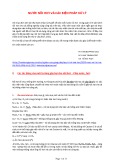

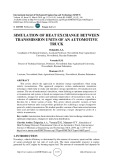
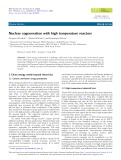
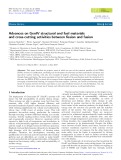



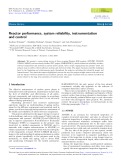






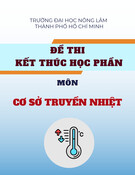
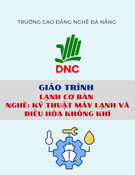
![Ngân hàng trắc nghiệm Kỹ thuật lạnh ứng dụng: Đề cương [chuẩn nhất]](https://cdn.tailieu.vn/images/document/thumbnail/2025/20251007/kimphuong1001/135x160/25391759827353.jpg)
